What is the Easiest Plant to Grow in Full Sun for Beginners?
When you’re thinking about brightening up your garden with some sun-loving plants, you want something that’s easy to manage. Lavender is one of the easiest plants to grow in full sun, and it’s a great starting point for any gardener. With its soothing scent and vibrant purple blooms, it not only beautifies your space but also attracts butterflies and bees.
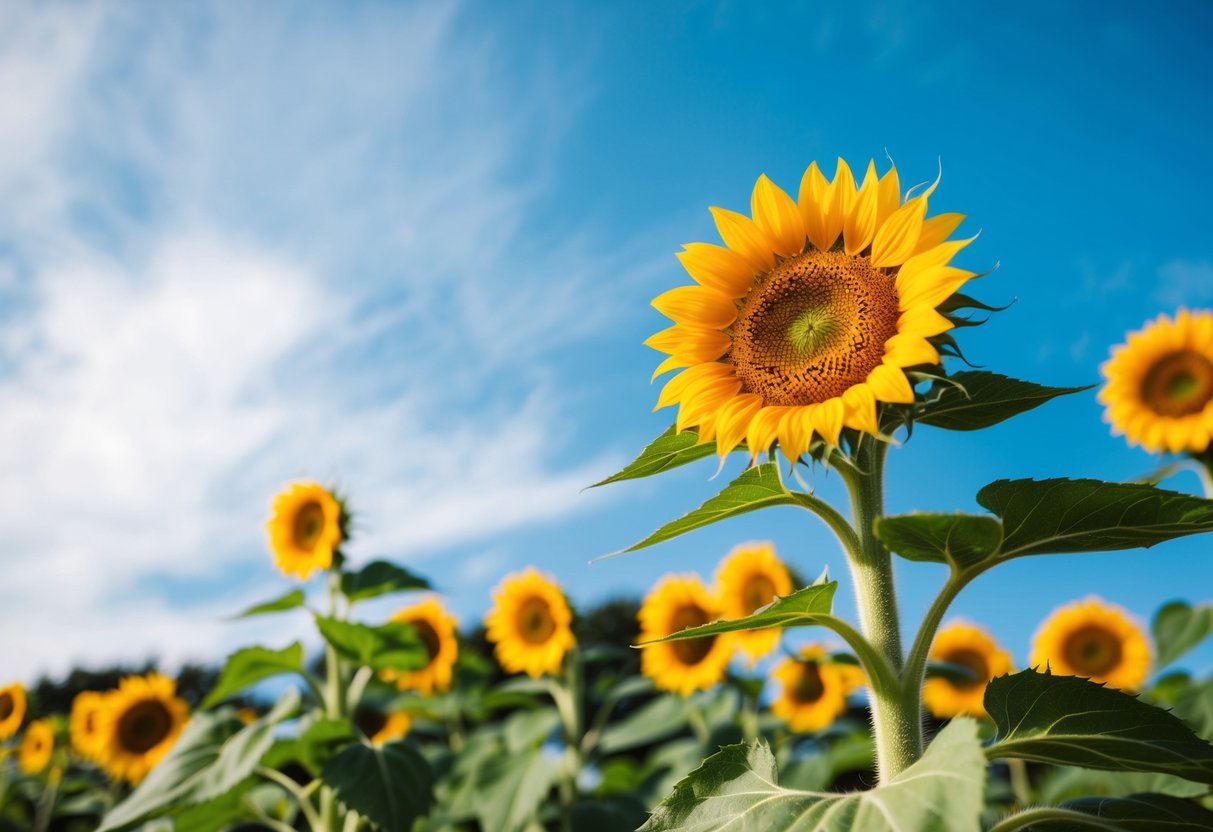
If you’re looking for variety, you might also like to consider Million Bells. This plant offers a range of colors like yellow, orange, and purple. They’re self-cleaning, meaning you don’t need to spend time deadheading, which makes them a low-maintenance option that thrives in sunny spots.
For those wanting to add some structure to their garden, Holly could be another excellent choice. This plant is known for its rigid foliage and red berries in cooler months, making it a year-round beauty in zones where it thrives. You can easily prune it to maintain the desired size, making it both decorative and manageable.
Choosing the Right Plants for Full Sun Gardens

When planning a garden in a sunny spot, it’s important to understand how to make the most of the conditions. By focusing on sunlight exposure, selecting the right soil, and choosing the right plants, you can create a vibrant space that thrives under the sun.
Understanding Sunlight and Exposure
Full sun means your plants will receive at least six hours of direct sunlight each day. This amount of sunlight is ideal for many flowering plants, vegetables, and herbs. It’s important to observe your garden space carefully to ensure it receives the necessary amount of light.
Be mindful of any structures or trees that might cast shadows during parts of the day. Consistent sunlight helps your plants grow strong, healthy, and loaded with flowers. Sun-loving plants have evolved to make use of intense light, so placing them in the right spot is key to their development.
Benefits of Growing Full Sun Perennials
Full sun perennials are great choices for sunny gardens because they come back year after year. Perennials such as lavender and coneflowers are prized for their hardiness and low maintenance. These plants are drought-resistant and can withstand hot, dry spells, making them reliable options for busy gardeners.
Many full sun perennials are vibrant and attract pollinators like bees and butterflies. By including these in your garden, you can support local ecosystems. Their long blooming periods also ensure your garden remains colorful and lively for months.
Selecting Soil Type for Sun-Loving Plants
Well-drained soil is crucial for plants that love full sun. Poor drainage can lead to waterlogged roots, causing plant stress and eventually root rot.
Before planting, it’s a good idea to amend your soil with compost or sand to improve its drainage properties.
Test your garden soil by digging a small hole and filling it with water. If it drains within a few hours, you’re good to go. Choosing the right soil type ensures your sun-loving plants have the nutrients and conditions they need to thrive all season long.
Top Easy-to-Grow Full Sun Perennials
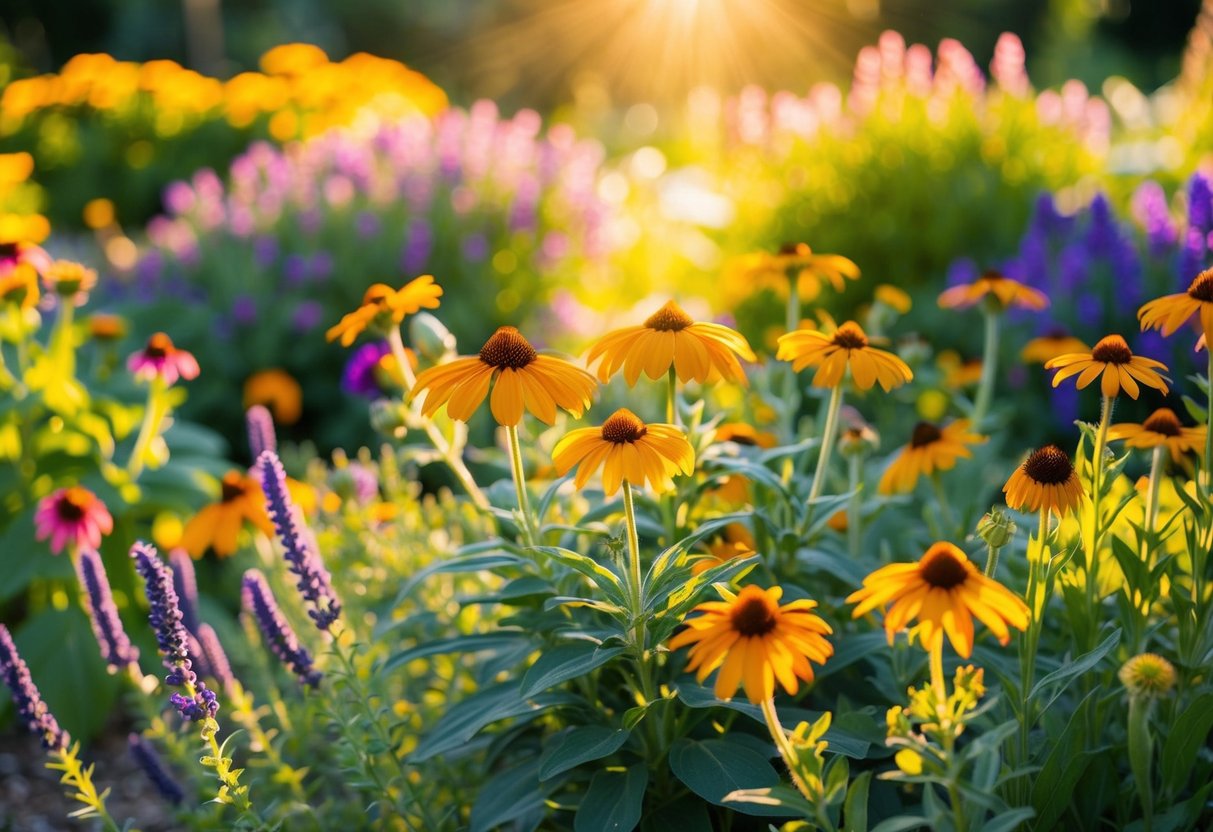
If you’re looking to brighten up your garden with minimal effort, consider these full sun perennials. They thrive in sunlight and reward you with vibrant blooms throughout the growing season. You’ll find these plants perfect for adding color and attracting pollinators.
Salvia: A Pollinator’s Favorite
Salvia is a wonderful choice for gardens full of sunshine. It’s known for its tall spikes of purple, blue, or red flowers. These blooms attract bees, butterflies, and hummingbirds, adding life to your outdoor space.
This perennial is drought-tolerant and can grow in different soil types. It typically reaches a height of 1 to 3 feet and blooms from late spring to fall. Prune the spent flowers to promote more blooms.
Salvia requires little maintenance once established. You’ll love its long-lasting color and the buzz of pollinators it brings to your garden.
Coneflowers: Beauty and Resilience
Coneflowers are standout perennials that add vibrant shades of purple, pink, and white to your garden. These daisy-like flowers are known for their raised centers and drooping petals.
They prefer full sun and can tolerate drought conditions, making them easy to care for. Coneflowers grow up to 2 to 4 feet tall, providing a striking vertical element in gardens.
They’re resilient and attract a variety of pollinators such as butterflies and bees. Additionally, their seeds are a favorite of birds. You’ll find coneflowers to be a versatile addition to any sunny bed.
Daylilies: Vibrant and Forgiving
Daylilies are incredibly forgiving and perfect for beginners. They come in many colors, including orange, yellow, and red, ensuring your garden stays lively.
These plants thrive in full sun and bloom throughout summer. Each flower lasts just one day, but new buds continuously open, keeping your garden colorful for weeks.
Daylilies are hardy and require minimal care. They’re known for surviving tough conditions, including poor soil and drought. Plant them, and you’ll enjoy their vibrant blooms with minimal maintenance for years.
Sedums: Succulent and Hardy
Sedums, or stonecrops, are charming with their fleshy leaves that store water. This makes them drought-resistant and ideal for full sun gardens.
They vary in size from ground covers to tall varieties, giving flexibility for different garden designs. Sedum flowers bloom in late summer and range from pink to yellow, adding unique textures to your landscape.
These succulents are low-maintenance and can thrive in poor soil. Their ability to withstand tough conditions makes sedums an excellent option for gardeners looking for a durable yet beautiful plant.
Caring for Your Full Sun Garden
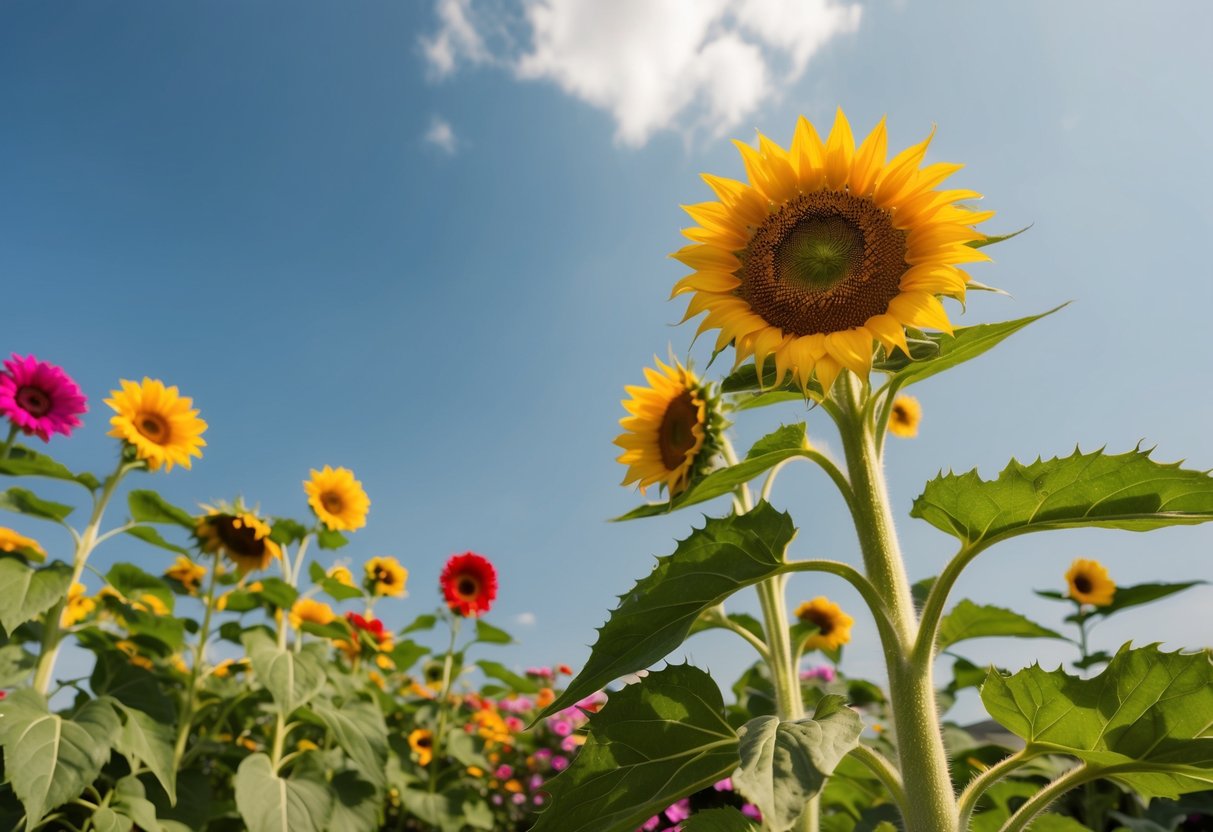
To keep your full sun garden looking vibrant, focus on proper watering, fertilizing, and pruning techniques. These practices will ensure your plants thrive under intense sunlight while minimizing maintenance.
Watering Strategies for Drought Tolerance
Plants that thrive in full sun often need special watering techniques to handle dry spells. Start by watering deeply but less often. This encourages the roots to grow deeper, making them more drought-tolerant.
Mulch around your plants to help retain moisture and reduce evaporation. During particularly hot periods, water early in the morning or late in the evening when the sun is less intense. This reduces water loss.
Consider using a drip irrigation system. It delivers water directly to the roots, minimizing waste and ensuring even distribution. This system is especially helpful for low-maintenance outdoor plants in full sun.
Fertilizing for Optimal Growth
For robust plant growth, regular fertilizing is important. Choose a balanced fertilizer that fits your specific plant needs and follow the instructions on the packaging.
Apply fertilizer during the growing season to provide nutrients when plants are most active.
If you’re growing flowering plants, look for a fertilizer with higher phosphorus levels. This promotes blooming, adding vibrant colors to your garden.
Composting is an excellent way to enrich soil naturally. By adding organic matter to the soil, you enhance its structure and fertility. This can provide a steady release of nutrients to keep plants healthy with minimal extra effort.
Pruning and Maintenance Tips
Pruning helps maintain plant health by removing dead or diseased branches. It can also shape plants to encourage new growth and improve airflow. This reduces disease risk and helps sun exposure reach all parts of the plant.
Use sharp, clean tools to make precise cuts. This minimizes damage and chance of disease.
Focus on removing any branches that cross or crowd the plant.
Regularly check for pests and diseases. Early detection ensures issues are dealt with promptly, keeping your garden in top condition. Even with low-maintenance plants, a little attention goes a long way.
Seasonal Considerations and Blooming Times
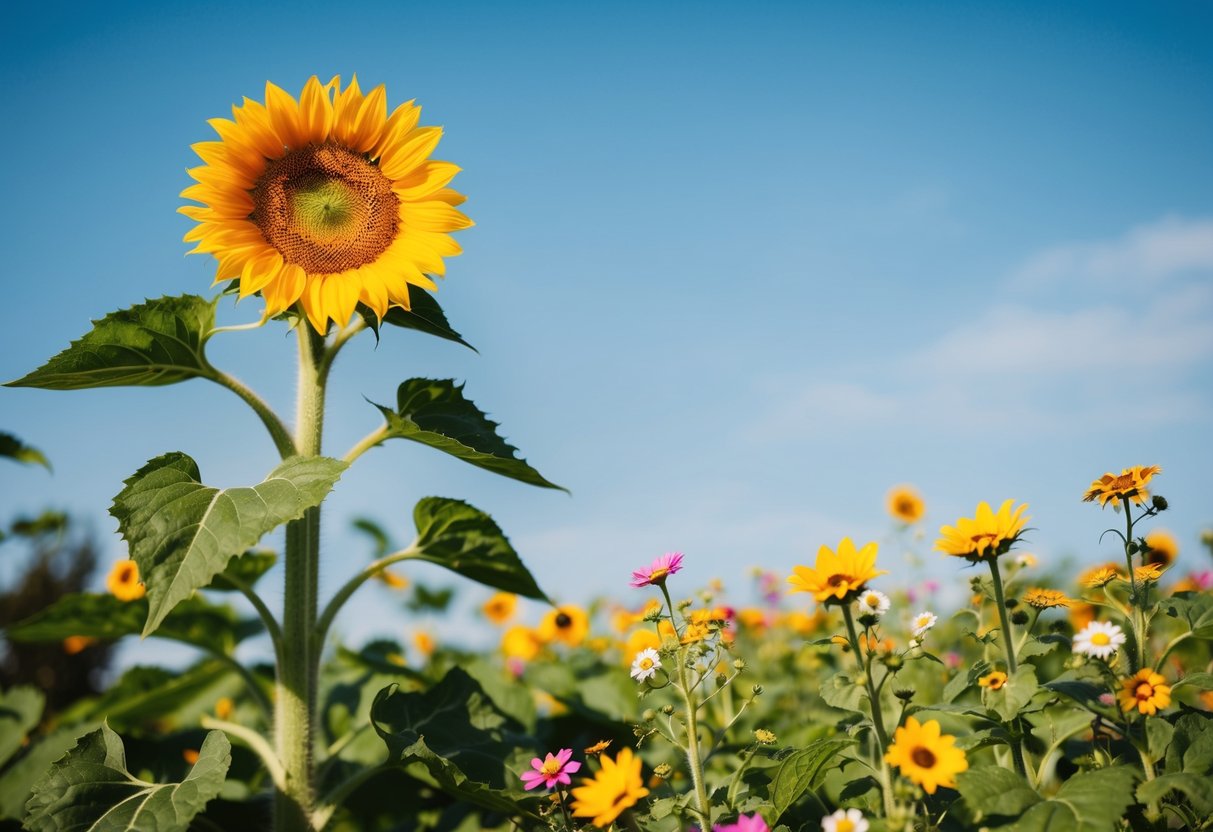
Understanding when your plants will bloom and how to prepare them for different seasons can help you maintain a vibrant garden all year long. Some plants, like hibiscus and daisies, have specific blooming periods, while others may thrive from spring to fall.
Spring to Fall: Seasonal Flowering Guide
During spring, many perennial flowers, such as echinacea purpurea and Shasta daisies, begin their blooming period. These plants often continue to showcase their vibrant colors well into summer.
Daylilies are another great choice, known for their showy blooms in hues of red, yellow, and pink, especially suited for full sun. As summer progresses, consider adding hibiscus moscheutos to your garden. These hardy plants enjoy the full sun and can bloom throughout summer.
To get the most out of your sun-loving plants, ensure they are suitable for your USDA hardiness zone. Many of these flowers thrive in zones 4 to 9, making them versatile choices for various regions. Timing your plantings based on your local climate helps them flourish through the seasons.
Preparing Your Plants for Winter
Winter preparation is key to ensuring your plants survive the colder months.
Start by trimming back any dead blooms and foliage from your perennial flowers. This helps prevent disease and improves their appearance once spring arrives.
For plants like hibiscus moscheutos, it’s essential to cover their base with mulch. This practice helps retain heat and protects roots from frost. In colder zones, some gardeners wrap more sensitive plants to shield them from winter chill.
Remember to remove fallen leaves and debris to reduce mold risks. By taking these steps, your garden will be ready to burst forth with colors as the weather warms.
Designing a Colorful and Sustainable Pollinator Garden
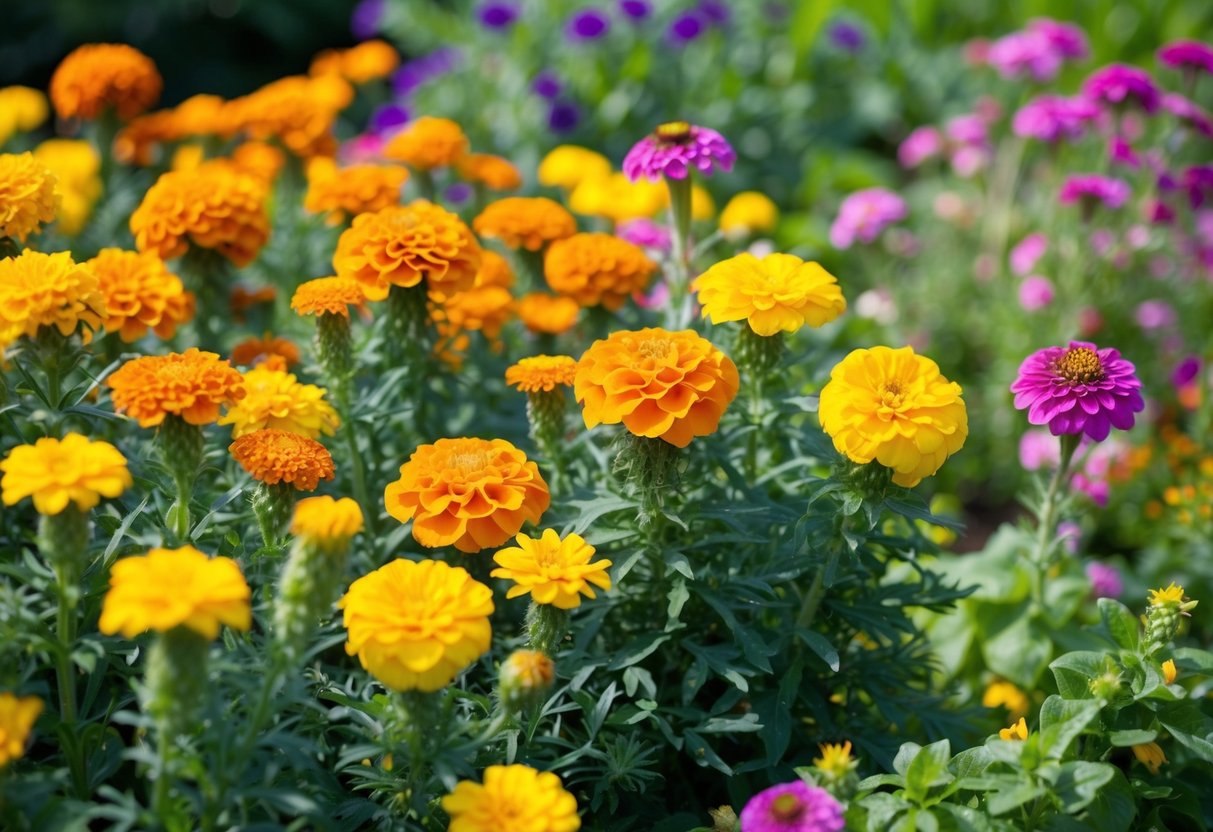
Creating a pollinator garden involves selecting vibrant flowers to attract pollinators like bees and butterflies while ensuring the garden supports wildlife sustainably. This approach enriches the environment and provides essential resources for local ecosystems.
Choosing Flowers for Pollinator Attraction
When planning your garden, pick plants that draw a variety of pollinators. Bee balm and cosmos are excellent choices due to their striking colors and nectar-rich blooms.
Consider planting shasta daisy and lanceleaf coreopsis for consistent flowering throughout the season.
Bearded iris can add height and texture to your garden. Native plants are often best, as they suit local pollinators well. Having a mix of shapes and colors ensures that you attract a broad range of pollinators.
Creating Sustainable Habitats for Wildlife
Design your garden to provide habitats that are friendly to wildlife. To achieve this, include a mixture of flowering plants like those mentioned above and host plants for caterpillars.
Incorporate places for pollinators to rest and find shelter from predators. Ensure a reliable water source is available, such as a small dish with pebbles. This allows pollinators to safely drink.
Aim for a layout that supports continuous blooming, providing food sources throughout the growing season. By focusing on sustainability, your garden will thrive and support a diverse range of pollinators.







